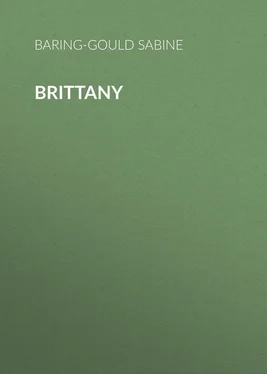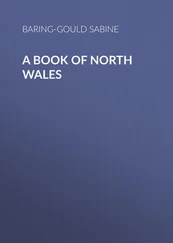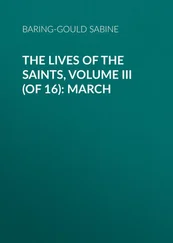Sabine Baring-Gould - Brittany
Здесь есть возможность читать онлайн «Sabine Baring-Gould - Brittany» — ознакомительный отрывок электронной книги совершенно бесплатно, а после прочтения отрывка купить полную версию. В некоторых случаях можно слушать аудио, скачать через торрент в формате fb2 и присутствует краткое содержание. Жанр: foreign_antique, foreign_prose, на английском языке. Описание произведения, (предисловие) а так же отзывы посетителей доступны на портале библиотеки ЛибКат.
- Название:Brittany
- Автор:
- Жанр:
- Год:неизвестен
- ISBN:нет данных
- Рейтинг книги:4 / 5. Голосов: 1
-
Избранное:Добавить в избранное
- Отзывы:
-
Ваша оценка:
- 80
- 1
- 2
- 3
- 4
- 5
Brittany: краткое содержание, описание и аннотация
Предлагаем к чтению аннотацию, описание, краткое содержание или предисловие (зависит от того, что написал сам автор книги «Brittany»). Если вы не нашли необходимую информацию о книге — напишите в комментариях, мы постараемся отыскать её.
Brittany — читать онлайн ознакомительный отрывок
Ниже представлен текст книги, разбитый по страницам. Система сохранения места последней прочитанной страницы, позволяет с удобством читать онлайн бесплатно книгу «Brittany», без необходимости каждый раз заново искать на чём Вы остановились. Поставьте закладку, и сможете в любой момент перейти на страницу, на которой закончили чтение.
Интервал:
Закладка:
At the present day, Brittany is still the stronghold of Catholicism in France. As to the rights of legitimists, Orleanists or Bonapartists, the peasants concern themselves little, but to touch their religion is to touch them to the quick. The Republican Government does all in its power to destroy the cohesion of the Breton people, and its attachment to the Faith of its Fathers. The masters have been forbidden to employ the Breton language in the schools, and in 1901 an order was addressed by Waldeck Rousseau to all the Bishops and Clergy of Lower Brittany forbidding them to preach in the language understood by the people, on pain of withdrawal of their stipends: an order that has been very properly disregarded.
Meanwhile national or rather provincial feeling is deepening and intensifying. Opposition only makes the Breton the more stubborn. The Breton has not much ambition. All he asks is to be left alone to work out his own destiny, strong in his religious convictions, "Français – oui, mais Breton avant tout."
IV. Antiquities
The prehistoric remains that abound in Brittany consist of Dolmens , i. e. a certain number of stones set on end rudely forming a chamber, and covered with one or more capstones.
The Allée Couverte is a dolmen on a large scale. Both served as family or tribal ossuaries.
The Menhir is a single standing stone; the alignment is a number of these uprights often in parallel lines, extending some distance.
The cromlech according to the signification accorded to it in France is a circle of standing stones.
The lech is the lineal descendant of the menhir. It is a stone often bearing an inscription, or a rude cross, set up by the British or Irish settlers. The lech is sometimes round.
Tumuli and Camps are numerous, but they are not often referred to in the following pages.
Of Roman remains , there are relics of an aqueduct near Carhaix, and there have been numerous villas uncovered, notably near Carnac, but these are almost all recovered with earth. The most remarkable Roman monument extant is the Temple of Mars, a fragment near Corseul.
The Venus of Quinipili, a Roman Gallic idol, shall be spoken of under the head of Baud.
Of early churches, – earlier than the 10th cent. there are none, there are but the crypt of Lanmeur and perhaps the arches and piers of Loconnolé near Morlaix, and possibly the Western arches of Plouguer by Carhaix that can be attributed to the 10th century. After that come considerable remains of Romanesque churches, beginning with the plain unmoulded round arch resting on plain rectangular piers, and gradually becoming enriched. (11th century and beginning of 12th.)
First pointed , with lancet windows, no tracery, and arches struck from two centres. (Middle of 12th century and beginning of 13th.)
Second pointed or Geometrical . Tracery becomes rich in windows, but always of a geometrical design. (Middle of 13th century and throughout 14th.)
Third pointed or Flamboyant . Tracery like flame, recurving, gradually all cusping abandoned. Arches employed in ornamentation struck from four centres. (15th century and beginning of 16th.)
Rénaissance. At first classic detail with Gothic outline, and tracery in its last decay. At last all tracery abandoned, and design stiffens and loses all Gothic feeling. (Middle of 16th century to middle of 17th.)
Baroque. Round headed windows, no tracery, clumsy mouldings, no taste whatever, but barbarous enrichment. (End of 17th century and 18th.)
V. The Pardons
The Pardons are the religious gatherings of the people, not often in the towns, but about some chapel on an island, on a hill top, in a wood. There may be seen the costumes in all their holiday beauty.
A Pardon begins with vespers on the night before the Feast. Pilgrims arrive for that, and sleep in the church, the chapel, under hedges. They sing their cantiques or hymns till they sing themselves to sleep. The first mass is said at 3 A.M. and the true pilgrims communicate till the last has received, when they depart. An ordinary visitor arriving, say at 10 A.M., will hardly see a single pilgrim. The rest come to join in the devotions. They attend mass, take part in the afternoon (3 P.M.) procession, and buy memorials, and ribbons, and sweetstuff, and pictures at the stalls.
Almost every Pardon has a character of its own, and a description of one by no means attaches to all. In Côtes-du-Nord the Pardon is only found genuine in the Breton speaking portion, elsewhere it has degenerated into an ordinary village feast.
Sometimes, and in some places, there is an evening procession carrying lighted candles, in some a bonfire figures lighted by a figure of an angel which descends from the chapel or church spire. At some there are wrestling and games in the afternoon, at others there is dancing, but usually all is quiet and the peasants disperse after the afternoon procession.
By the sea, the arrival of the boats with maidens in white and banners is a pretty sight; at one Pardon, the sailors proceed, barefooted in their shirts, in performance of a vow, when delivered in a storm.
A visitor who desires to be present at one of the most popular Pardons should secure rooms a month beforehand, and even then he may be dispossessed if the Government or military authorities have seized on the occasion of a Pardon to billet a regiment on the place, an experience the writer has twice had to undergo.
Another quarter century will probably see the last of the Pardons. It will not be due to the decay of the religious feeling among the people – that need not be feared – but to Governmental opposition, and the indecent behaviour of the tripper, which will perhaps induce the clergy to discourage them. (Matt. vii. 6.) A word to the invariably courteous and kindly curé will often secure for the visitor a place of vantage in the gallery, and it is only due to him to ask if he objects to a snap-shot with the kodak at the procession. To photograph a man when engaged in his devotions, or a woman making her painful pilgrimage barefooted is not calculated to impress the peasant with the good-feeling of the English visitor. The Breton is tender-hearted and sensitive, and should ever be respected. At a great Basse-Bretagne Pardon and fair, one may wander till late among the thousands gathered there, enjoying themselves on merry-go-rounds and at shooting stalls, and see no horseplay, no rudeness, no drunkenness.
At a Pardon one sees and marvels at the wondrous faces of this remarkable people: – the pure, sweet and modest countenances of the girls, and those not less striking of the old folk. "It is," says Durtal ( En Route ), "the soul which is everything in these people, and their physiognomy is modelled by it. There are holy brightnesses in their eyes, on their lips, those doors to the borders of which the soul alone can come, from which it looks forth and all but shows itself."
Goodness, kindness, as well as a cloistral spirituality stream from their faces. One incident may be noticed to show of what stuff their charity consists. After the wreck of the Drummond Castle when the bodies were washed up on the Ile-Molène, the women readily gave up their holiday costumes – costumes which it takes a girl twenty years of economies to acquire – and in these they clothed and buried the dead women washed ashore.
The Pardons in the Bigauden district are the most showy. The Bigaudens delight in bright colours, but they are not a religious or a moral people, and they do not exhibit the fervent and deep-seated piety of the genuine Bretons. The Bigaudens occupy the promontory of Sizun and Pont l'Abbé. This people, peculiar in appearance and distinct in character from the Bretons, are supposed to belong to the primitive population of Ivernians before the coming of the British colonists. They are looked on with mistrust, if not aversion by the Bretons, whom they can generally over-reach in a bargain.
Читать дальшеИнтервал:
Закладка:
Похожие книги на «Brittany»
Представляем Вашему вниманию похожие книги на «Brittany» списком для выбора. Мы отобрали схожую по названию и смыслу литературу в надежде предоставить читателям больше вариантов отыскать новые, интересные, ещё непрочитанные произведения.
Обсуждение, отзывы о книге «Brittany» и просто собственные мнения читателей. Оставьте ваши комментарии, напишите, что Вы думаете о произведении, его смысле или главных героях. Укажите что конкретно понравилось, а что нет, и почему Вы так считаете.












